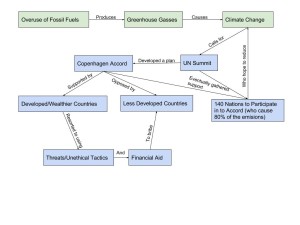The diagram I created links together the impacts on the environment (shown in green) and the societal factors contributing to it (boxes in blue). This article and topic doesn’t go deep into detail about the climate itself; instead it focuses on the diplomatic relations behind trying to solve the problem. It starts with the problem of overusing fossil fuels (mostly by developed countries), which results in too much greenhouse gas being emitted. This is the core cause of the climate change we are experiencing. For this specific situation, the link to climate change is mostly through the UN Summit and the Copenhagen Accord that was developed by it. After the Copenhagen Accord, the flow chart shows how the more developed countries were more supportive of the plan than the less developed countries. This was mainly due to the wealthier countries being able to shape the plan around their own agendas more than strictly working to improve climate change. Meanwhile, the less wealthy and developed ones suffer from the fallout of climate change that they didn’t cause. In order to push the plan forward and into action, the U.S. and others resorted to unethical tactics such as financial aid bribery, spying, and other threats in order to almost force the unsupportive countries into changing their minds. Eventually, 140 countries pledged to support the Copenhagen Accord. This is within the intended target number of countries, who account for about 80% of the greenhouse emissions. Whether the tactics used to gather this support is viewed as unethical or not, the plan will still hopefully bring a reduction in greenhouse gasses and an improvement in climate change.
I think this article did a great job of displaying how hard it can be to gather widespread support to improve climate change. As mentioned in the article, this is a collective action issue. Not only that, but the collective action needs to happen on many levels and scales. Different countries all need to do their part in reducing emissions, as well as the individual people within these countries on a daily basis. This article focused on an example at the worldwide and diplomatic scale. The U.S. and other wealthy countries put their personal interests ahead of making large steps to solve the problem, through their support of the less binding and weaker Copenhagen Accord. I think the approach taken by the U.S. and some other countries was ethically wrong and futile for long term improvement. Offering aid to countries who are in a position of need is something these poorer countries cannot refuse, even if it means supporting a plan that they wish to not support. This defeats the purpose of having a plan that’s is agreeable by all nations involved, since only the more powerful ones truly wish for it to be implemented. This outcome was a way for the United States and others to act as if they are doing their part, when in reality they are pushing back the real change necessary. I think the information that was leaked should have been publicly available in the first place. If that were the case, public pressure likely would have forced the U.S. to come to a more agreeable and more effective plan, rather than forcing those who disagree to change stances. I think the UN Summit needs to reevaluate this plan and revise it so that all countries involved truly can agree on a solution. That is the only way we can work to reduce climate change effectively in the long run.


Hey, my name is Katelyn. The link to my blog is http://sites.psu.edu/geog30/2016/04/09/climate-change-12/
I agree with you and what Ava said above. The information should be publicly available for anyone to see. The US could have gone about this in a different way. I think they should have communicated and negotiated with the other countries instead of threatening them or bribing them.
Hey Ava, I’m Tyler. Here’s my article: http://geog030.dutton.psu.edu/2016/04/09/module-nine-climate-change/ I like how you mentioned the bribes given to poorer countries. They’re not all that wasteful and money means a lot to them. I agree that the information should be publicly available. The US should gets its act together.